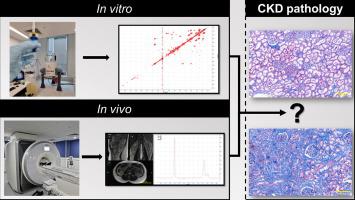Progress in Nuclear Magnetic Resonance Spectroscopy ( IF 7.3 ) Pub Date : 2023-04-08 , DOI: 10.1016/j.pnmrs.2023.04.001 Tyrone L R Humphries 1 , David A Vesey 1 , Graham J Galloway 2 , Glenda C Gobe 2 , Ross S Francis 1

|
Chronic kidney disease (CKD) affects approximately 10% of the world population, higher still in some developing countries, and can cause irreversible kidney damage eventually leading to kidney failure requiring dialysis or kidney transplantation. However, not all patients with CKD will progress to this stage, and it is difficult to distinguish between progressors and non-progressors at the time of diagnosis. Current clinical practice involves monitoring estimated glomerular filtration rate and proteinuria to assess CKD trajectory over time; however, there remains a need for novel, validated methods that differentiate CKD progressors and non-progressors. Nuclear magnetic resonance techniques, including magnetic resonance spectroscopy and magnetic resonance imaging, have the potential to improve our understanding of CKD progression. Herein, we review the application of magnetic resonance spectroscopy both in preclinical and clinical settings to improve the diagnosis and surveillance of patients with CKD.






























 京公网安备 11010802027423号
京公网安备 11010802027423号